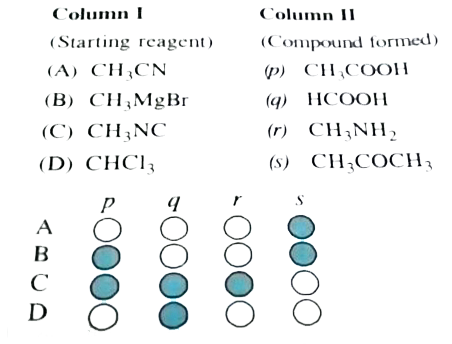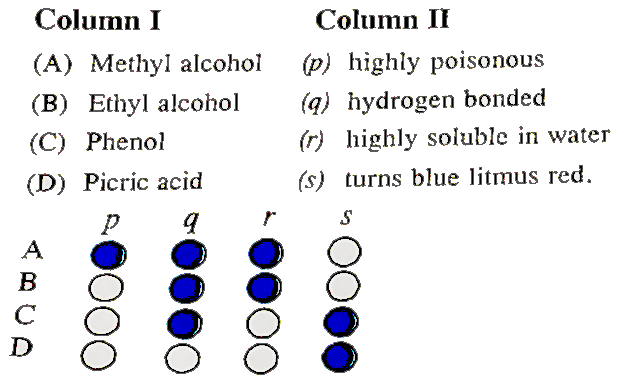Match the factors( in column-II) with properticlues ( in column -I) which undergo change with charge in ltbgt factors in column -II.
Column IColumn II(A)Work function(P)Wavelength of photon used(less than threshold wavelength)(B)Threshold frequency(Q)Photo intensity of light(C)Stopping potential(R)Distance of point source from metal plate(D)Photo current(v>v0)(S)Metal
The correct Answer is:(A)S,(B)S,(C)P,S(D)Q,R
Step by step video, text & image solution for Match the factors( in column-II) with properticlues ( in column -I) which undergo change with charge in ltbgt factors in column -II. {:(,"Column I", , "Column II"),((A),"Work function",(P),"Wavelength of photon used" ("less than threshold wavelength")),((B),"Threshold frequency",(Q),"Photo intensity of light"),((C),"Stopping potential",(R),"Distance of point source from metal plate"),((D),"Photo current" (v gt v_(0)),(S),"Metal"):} by Chemistry experts to help you in doubts & scoring excellent marks in Class 11 exams.
Updated on:21/07/2023Topper's Solved these Questions
Similar Questions
Match the extraction processes listed in Column I with metals listed in Column II.
Column IColumn IIA.Self reductionp.LeadB.Carbon reductionq.SilverC.Complex formation and displacement by metal r.CopperD. Decomposition of iodides.Boron
View SolutionMatch the extraction processes listed in Column I with metals listed in Column II.
Column IColumn II(A)Self reduction(p)Lead(B)Carbon reduction(q)Silver(C)Complex formation and displacement by metal(r)Copper(D)Decomposition of iodide(s)Boron
View SolutionMatch the statement (A,B,C,D) in column I with the statement (p,q,r,s) in column II. The answers are to be properly bobbled.

View SolutionMatch the term given in column I with its description in Column II
Column I Column II(a)Path function (p)Heat(b)State function (q)Internal energy (c)Intensive property(r)Entropy(d)Extensive property (s)Specific heat
View SolutionMatch the statements (A,B,C,D) in column I with the statements (p,q,r,s) is column II. The answers to the question have to be properly bubbled.

View Solution[" 3.The work function of metal is "2.4eV" ."],[" Find the (i) threshold frequency for "],[" metal "],[" (ii) wavelength of incident light if a "],[" stopping potential is "0.5V" ."]
View SolutionMatch the statement (A, B, C, D) in column I with statement (p, q, r, s) in column II. The answers to the question are to be properly bubbled.

View SolutionIn the shown expermiental setup to study photoelectric effect, two conducting electrodes are enclosed in an evacuated glass-tube as shown. A parallel beam of monochromatic light, falls on photosensitive electrodes. The emf of battery shwon is high enough such that all photoelectron ejected from left electrode will reach the right electrode. Under initial conditions photoelectrons are emitted. AS changes are made in each situation of column-I, Match the statements in column-I with results in column-II.
_E01_128_Q01.png)
Column IColumn II(A)If frequency of incident light is increased keeping its intensity constant(p)magnitude of stopping potential(B)If frequency of incident light is increased and its intensity is decreased(q)current through circuit may stop(C)If work function of photo sensitive electrode is increased(r)maximum kinetic energy of ejected photoelectrons will increase(D)If intensity of incident light is increased keeping its frequency constant(s)saturation current will increase
View SolutionMatch the following columns.
∣∣ ∣ ∣ ∣ ∣ ∣ ∣ ∣∣Column IColumn II(A)d v/dt(p)Acceleration(B)d|v|/dt(q)Magnitude of acceleration(C)drdt(r)Velocity(D)∣∣drdt∣∣(s)Magnitude of velocity(t)Rate of change of speed∣∣ ∣ ∣ ∣ ∣ ∣ ∣ ∣∣
View SolutionMatch the conversions in Column I with the type(s) of reaction(s) given in Column II.
Column IColumnIIA.PbS→PbOp.RoastingB.CaCo3→CaOq.CalcinationC.ZnS→Znr.Carbon reductionD.Cu2S→Cus.Self-reduction
View Solution